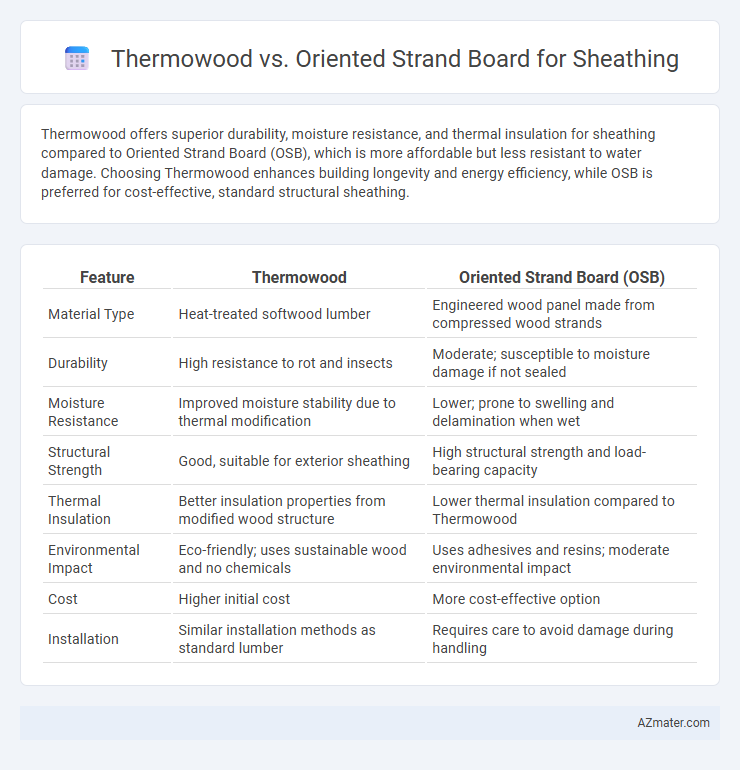Thermowood offers superior durability, moisture resistance, and thermal insulation for sheathing compared to Oriented Strand Board (OSB), which is more affordable but less resistant to water damage. Choosing Thermowood enhances building longevity and energy efficiency, while OSB is preferred for cost-effective, standard structural sheathing.
Table of Comparison
| Feature | Thermowood | Oriented Strand Board (OSB) |
|---|---|---|
| Material Type | Heat-treated softwood lumber | Engineered wood panel made from compressed wood strands |
| Durability | High resistance to rot and insects | Moderate; susceptible to moisture damage if not sealed |
| Moisture Resistance | Improved moisture stability due to thermal modification | Lower; prone to swelling and delamination when wet |
| Structural Strength | Good, suitable for exterior sheathing | High structural strength and load-bearing capacity |
| Thermal Insulation | Better insulation properties from modified wood structure | Lower thermal insulation compared to Thermowood |
| Environmental Impact | Eco-friendly; uses sustainable wood and no chemicals | Uses adhesives and resins; moderate environmental impact |
| Cost | Higher initial cost | More cost-effective option |
| Installation | Similar installation methods as standard lumber | Requires care to avoid damage during handling |
Introduction to Sheathing Materials
Sheathing materials such as Thermowood and Oriented Strand Board (OSB) serve as essential structural components in building envelopes, providing support and rigidity to walls, roofs, and floors. Thermowood, a heat-modified timber, offers enhanced durability, moisture resistance, and dimensional stability, making it suitable for exterior applications exposed to harsh weather conditions. OSB, manufactured from compressed wood strands and adhesives, delivers cost-effective strength and uniformity, commonly used in residential and commercial sheathing for its versatility and ease of installation.
What is Thermowood?
Thermowood is a type of wood that has been thermally modified through a controlled heating process, enhancing its durability, stability, and resistance to decay without the use of chemicals. This modification increases Thermowood's dimensional stability and makes it highly suitable for exterior sheathing applications where moisture resistance is crucial. Compared to Oriented Strand Board (OSB), Thermowood offers superior longevity and natural resistance to weather conditions, making it a premium choice for projects demanding durable and environmentally friendly materials.
Overview of Oriented Strand Board (OSB)
Oriented Strand Board (OSB) is a highly engineered wood panel made from layers of compressed wood strands arranged in cross-oriented patterns for enhanced strength and durability. It is widely used for sheathing in construction due to its cost-effectiveness, uniformity, and resistance to warping compared to traditional plywood. OSB provides excellent structural performance, moisture resistance when treated, and is suitable for walls, roofs, and floors in residential and commercial buildings.
Thermal Performance Comparison
Thermowood offers superior thermal insulation due to its low thermal conductivity and enhanced moisture resistance, resulting in better energy efficiency for building envelopes. Oriented Strand Board (OSB) provides moderate thermal performance but can be prone to moisture absorption, which may reduce its insulating properties over time. Choosing Thermowood for sheathing improves long-term thermal performance and durability in various climate conditions compared to OSB.
Moisture Resistance: Thermowood vs OSB
Thermowood offers superior moisture resistance compared to Oriented Strand Board (OSB) due to its thermal modification process, which reduces wood hygroscopicity and enhances dimensional stability. OSB tends to absorb water more readily, leading to swelling and potential degradation in sheathing applications exposed to high humidity or water intrusion. Choosing Thermowood for sheathing ensures longer-lasting protection and structural integrity in moist environments.
Durability and Lifespan
Thermowood offers superior durability and an extended lifespan compared to Oriented Strand Board (OSB) due to its heat-treated process that enhances resistance to moisture, decay, and insect damage. OSB, while cost-effective and structurally strong, is more susceptible to swelling, delamination, and degradation when exposed to prolonged moisture. For sheathing applications requiring long-term durability and minimal maintenance, Thermowood presents a more robust solution with greater dimensional stability and resistance to environmental stresses.
Environmental Impact and Sustainability
Thermowood offers superior environmental benefits compared to Oriented Strand Board (OSB) due to its chemical-free thermal modification process, which increases durability and reduces the need for harmful preservatives. OSB production typically relies on adhesives and resins derived from petrochemicals, contributing to higher VOC emissions and a larger carbon footprint. Thermowood's sustainable sourcing from certified forests and its extended lifespan make it a more eco-friendly sheathing option for green building projects.
Cost Analysis: Thermowood vs OSB
Thermowood generally costs more than Oriented Strand Board (OSB) due to its specialized heat treatment process that enhances durability and resistance to decay. OSB provides a cost-effective sheathing solution with prices significantly lower per sheet, making it a preferred option for budget-conscious construction projects. When evaluating cost-effectiveness, Thermowood offers long-term value through reduced maintenance, while OSB delivers upfront savings and widespread availability.
Installation and Workability
Thermowood offers superior workability due to its lightweight and uniform density, making it easier to cut, nail, and shape during installation compared to Oriented Strand Board (OSB). OSB, composed of compressed wood strands and resin, provides excellent structural durability but can be more challenging to fasten and requires careful handling to avoid swelling in moist conditions. Thermowood's dimensional stability and resistance to warping enhance installation efficiency, while OSB's cost-effectiveness and consistent thickness make it a popular choice for large-scale sheathing projects.
Best Applications and Recommendations
Thermowood, known for its enhanced durability and natural resistance to moisture and decay, is ideal for exterior sheathing applications requiring long-term weather exposure such as siding and cladding. Oriented Strand Board (OSB) offers strong structural performance and cost efficiency, making it suitable for wall, roof, and floor sheathing in typical residential and commercial construction. For projects prioritizing aesthetics and longevity, Thermowood is recommended, while OSB is preferred for budget-conscious builds needing reliable structural support.

Infographic: Thermowood vs Oriented Strand Board for Sheathing
 azmater.com
azmater.com